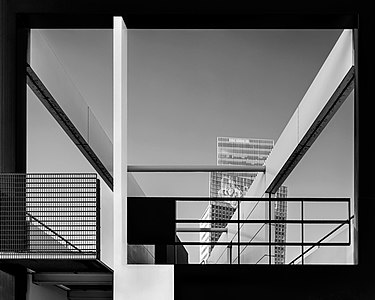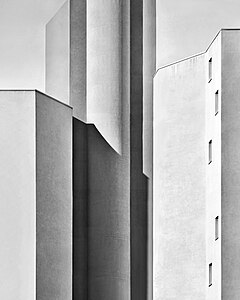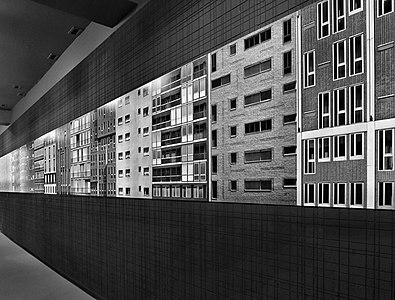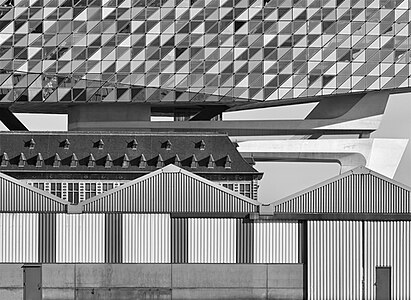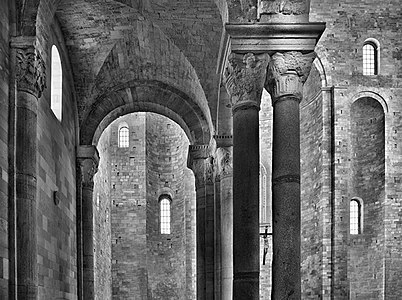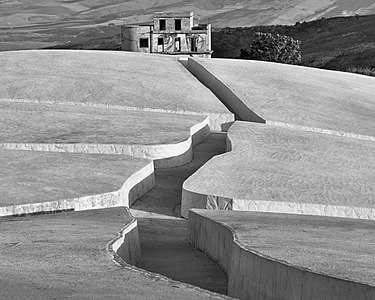Biography and work
Musi was born and grew up in Salerno, Italy and taught himself black-and-white photography beginning at age fourteen. In 1982 he had his first exhibition at the Venice Biennale, entitled Maschere e Persone, images depicting popular religious and pagan rituals in Southern Italy. In the 1980s he collaborated with the sculptor Ugo Marano in a work called The Artist's Rooms, photographing the installations of Marano, made of ceramic, iron and wood. [1]
Architectural photography
In the 1990s he began creating books of photographs of modern architecture, always in black and white, presenting the buildings as complex works of visual art, with contrasts and harmonies of light and darkness. His early photo books included Mario Botta seen by Pino Musi, depicting the work of the architect Mario Botta, especially Évry Cathedral, the only modernist cathedral completed in the 20th century; a photographic study of the Chapelle Notre Dame du Haut à Ronchamp, the Modernist church designed by Le Corbusier; and a book devoted on the work of the 1930s avant-garde architect Giuseppe Terragni.
In 2012 he presented Facecity (scroll) at the Biennale of Architecture in Venice. This was a series of twenty-one photographs of buildings in Milan built in the 1950s and 1960s. The images were edited to remove ornament or other signs that would distract from the architecture. The intention, Musi explained, was that the images would interact with each other, like the counterpoints and dissonances in music. [2]
The book "Border Soundscapes" (2019) illustrated Musi's theme of the similar effects achieved by music and photography, through contrasts of light and dark, loudness and softness, and variations of key and harmony. [3]
Cityscape of Rotterdam, from "Corpi d'Architettura" (1995-2021)
From “Polyphōnia" (2021)
"Facecity" scroll (2012) at the
Venice Biennale Cityscape of Antwerp, from "Corpi d'Architettura" (1995-2021)
Archeology
In 2003 he created Libro, a book of closeup photographs of pages from early books, with a text by Cesare de Seta. Other books explored the stark traditional rural architecture of Terra del Sarno region (Metonimie) and the rural settlements in the Campania region (Per cammino d'ombre).
In 2010, he turned to archeology and classical architecture with two new photo books; Italia. Bellezza Eterna and Italia. Bellezza e Fede, with texts by Louis Godart. In 2019 he published Grecia. Le radici della Civiltà Europea (Greece the roots of European civilisation), with a text by Flaminio Gualdoni. These books used tri-tone separations in reproducing the black and white photographs, with each image occupying a full page. In 2019 he continued the series with La Grecia di Pino Musi (The Greece of Pino Musi), also with a text by Gualdoni. He also created a book illustrating the rustic architecture of Sicily and its interaction with the landscape.
Pages of "Greece, roots of European Civilisation"
Trani Cathedral, from "Corpi d'Archeologia" (2010-2020)
Grande Cretto di Burri, Gibellina, Sicily (2019)
From "Sottotraccia" (2019)
Industrial photography and "Operating Theatre"
In parallel with architectural photography, he published a series of photo books of industrial plants and machinery. In 2008, Musi produced Steel City, a work illustrating the process of making steel in one of the largest Italian steel mills (ILVA at Taranto). He was commissioned to document the stages involved in steel processing by the Riva Group. His images concentrated on the furnaces, the machinery, and the molten steel. The light in the images was provided by the furnaces. [4]
This was followed by another project, Operating Theatre in 2013, a book of black and white photographs of surgical operating rooms, each taken five minutes after the completion of an operation. The rooms are empty of people, but the surgical couch, scattered instruments, fabrics and debris suggest the drama that took place in the same space a few minutes earlier. [5]

Enric Miralles Moya was a Spanish architect from Barcelona, Catalonia. He graduated from the Barcelona School of Architecture (ETSAB) at the Universitat Politècnica de Catalunya (UPC) in 1978. After establishing his reputation with a number of collaborations with his first wife Carme Pinós, the couple separated in 1991. Miralles later married fellow architect Benedetta Tagliabue, and the two practiced together as EMBT Architects. Miralles' magnum opus and his largest project, the new Scottish Parliament Building, was unfinished at the time of his death.

Achille Bonito Oliva is an Italian art critic and historian of contemporary art. Since 1968 he has taught history of contemporary art at La Sapienza, the university of Rome. He has written extensively on contemporary art and contemporary artists; he originated the term Transavanguardia to describe the new direction taken in the late 1970s by artists such as Sandro Chia, Francesco Clemente, Enzo Cucchi, Nicola De Maria, and Mimmo Paladino. He has organised or curated numerous contemporary art events and exhibitions; in 1993 he was artistic director of the Biennale di Venezia.

Piero Manzoni di Chiosca e Poggiolo, better known as Piero Manzoni was an Italian artist best known for his ironic approach to avant-garde art. Often compared to the work of Yves Klein, his own work anticipated, and directly influenced, the work of a generation of younger Italian artists brought together by the critic Germano Celant in the first Arte Povera exhibition held in Genoa, 1967. Manzoni is most famous for a series of artworks that call into question the nature of the art object, directly prefiguring Conceptual Art. His work eschews normal artist's materials, instead using everything from rabbit fur to human excrement in order to "tap mythological sources and to realize authentic and universal values".
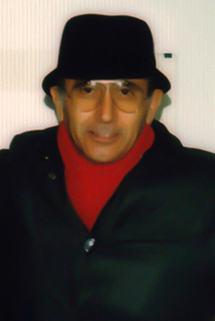
Franco Fontana is an Italian photographer. He is best known for his abstract colour landscapes.
Venice Biennale of Architecture is an international exhibition of architecture from nations around the world, held in Venice, Italy, every other year. It was held on even years until 2018, but 2020 was postponed to 2021 due to the COVID-19 pandemic shifting the calendar to uneven years. It is the architecture section under the overall Venice Biennale and was officially established in 1980, even though architecture had been a part of the Venice Art Biennale since 1968.

Emily Jacir is a Palestinian artist and filmmaker.

Caterina Davinio is an Italian poet, novelist and new media artist. She is the author of works of digital art, net.art, video art and was the creator of Italian Net-poetry in 1998.
Gianfranco Goberti was an Italian painter.
Luigi Ghirri was an Italian artist and photographer whose work was about the relationship between fiction and reality. Ghirri has been the subject of numerous books. His works are held by various museums around the world and have been exhibited in the 2011 Venice Biennale and at MAXXI in Rome.
Luca Campigotto is an Italian artist photographer and writer.
In 2000 Paolo Brescia and Tommaso Principi established the collective OBR to investigate new ways of contemporary living, creating a design network among Milan, London and New York. After working with Renzo Piano, Paolo and Tommaso have oriented the research of OBR towards the integration artifice-nature, to create sensitive architecture in perpetual change, stimulating the interaction between man and environment. The team of OBR develops its design activity through public-private social programs, promoting – through architecture – the sense of community and the individual identities. Today OBR is group open to different multidisciplinary contributors, cooperating with different universities, such as Accademia di Architettura di Mendrisio, Aalto University, Academy of Architecture of Mumbai and Mimar Sinan Fine Art University. Among the best known works by OBR are the Pythagoras Museum, the New Galleria Sabauda in Turin, the Milanofiori Residential Complex, the Children Hospital in Parma, the Galliera Hospital in Genoa, the Lido of Genoa, the Ex Cinema Roma, the Triennale di Milano Terrace. The under construction projects by OBR include the Lehariya Cluster in Jaipur, the Jafza Traders Market in Dubai and the Multiuse Complex Ahmad Qasir in Teheran. OBR's projects have been featured in Venice Biennale of Architecture, Royal Institute of British Architects in London, Bienal de Arquitetura of Brasilia, MAXXI in Rome and Triennale di Milano. OBR has been awarded with the AR Award for Emerging Architecture at RIBA, the Plusform under 40, the Urbanpromo at the 11° Biennale di Venezia, the honourable mention for the Medaglia d'Oro all'Architettura Italiana, the Europe 40 Under 40 in Madrid, the Leaf Award overall winner in London, the WAN Residential Award, the Building Healthcare Award, the Inarch Award for Italian Architecture and the American Architecture Prize in New York. Since 2004 OBR has been evolving its design parameters according to the environmental and energy certification LEED and since 2009 OBR is partner of the GBC.
Jean Soldini is a Swiss and French philosopher, art historian and poet.

Bruno Ceccobelli is an Italian painter and sculptor. He currently resides and works in Todi, Italy. Ceccobelli was one of the six artists of the Nuova Scuola Romana or Scuola di San Lorenzo, an artistic movement that grew out of the Arte Povera and Transavanguardia movements of the latter twentieth century.

The Italian photographer Gianni Berengo Gardin has been the sole contributor or a major contributor to a large number of photobooks from 1960 to the present.

Guido Guidi is an Italian photographer. His work, spanning over more than 40 years, has focused in particular on rural and suburban geographies in Italy and Europe. He photographs places that are normally overlooked. His published works include In Between Cities,Guardando a Est,A New Map of Italy and Veramente.
Albino Lucatello was a modern Italian painter.
Antonio Martinelli is a French-Italian photographer born on 30 September 1953 in Venice, Italy. He currently lives in Paris.
Alban Muja is a Kosovan contemporary artist and film-maker. In 2019 he represented Kosovo at the 58th Venice Biennale. In his work he is mostly influenced by the social, political and economical transformation processes in wider surrounding region, he investigates history and socio-political themes and links them to his position in Kosovo today. His works cover a wide range of media including video installation, films, drawings, paintings, photographs and performance which have been exhibited extensively in various exhibitions and festivals.
Alessandro Melis is an Italian architect and the curator of the Italian National Pavilion at the 17th Venice Biennale. He is also a professor of architecture and the inaugural endowed chair of the New York Institute of Technology.
Lea Vergine, born Lea Buoncristiano, was an Italian art critic, essayist and curator.


